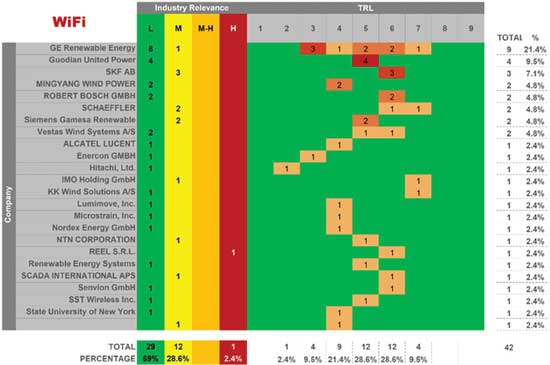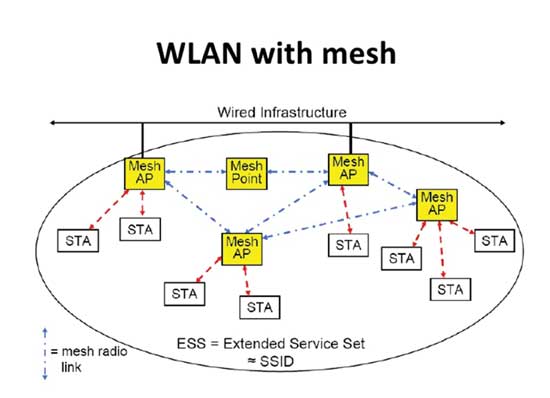 The implementation of wireless technology using the 802.11s standard and mesh network technology will revolutionise wind turbine and wind park control systems. The increased signal fidelity and packet routing central to this technology will allow more WiFi-enabled sensor networks to be implemented on wind turbine blades. Previous attempts at fully instrumented blade monitoring using optical fibre sensors were expensive and limited in fidelity due to reliability issues. While the subject of WiFi use in pitch control, SCADA and content management systems (CMS), and other communication uses in wind turbines has been discussed for many years, some of the same constraints related to bandwidth and system reliability in the face of lightning strikes and 20-year design life have thus far precluded commercial use.
The implementation of wireless technology using the 802.11s standard and mesh network technology will revolutionise wind turbine and wind park control systems. The increased signal fidelity and packet routing central to this technology will allow more WiFi-enabled sensor networks to be implemented on wind turbine blades. Previous attempts at fully instrumented blade monitoring using optical fibre sensors were expensive and limited in fidelity due to reliability issues. While the subject of WiFi use in pitch control, SCADA and content management systems (CMS), and other communication uses in wind turbines has been discussed for many years, some of the same constraints related to bandwidth and system reliability in the face of lightning strikes and 20-year design life have thus far precluded commercial use.
By Philip Totaro, Founder & CEO, IntelStor, LLC
From Totaro’s IP Prism innovation analysis platform, the current technology development on WiFi use seems to indicate that most innovations are still immature at technology readiness level 4–6.
Nevertheless, the push towards digitalisation including IoT-enabled sensor deployment is resulting in the implementation of more sophisticated sensor systems and networks to handle the volume of data. Bandwidth limitations and data volumes necessitate an IoT-based smart sensor in which some of the data post-processing could be handled ‘on the chip’ prior to being transmitted back to the SCADA or CMS server. Blade-mounted sensor networks and localised access points combined with nacelle-mounted routers and mesh points will eliminate a significant amount of ethernet cabling and will also eliminate the need for pitch system slip-rings (at least for communication and power). The blade-mounted sensors can be wirelessly charged and could even comprise a long-talked-about technology using a piezoelectric actuator to leverage motion and vibration to power the sensor.
Blade-mounted sensor networks and localised access points combined with nacelle-mounted routers and mesh points will eliminate a significant amount of ethernet cabling and will also eliminate the need for pitch system slip-rings (at least for communication and power). The blade-mounted sensors can be wirelessly charged and could even comprise a long-talked-about technology using a piezoelectric actuator to leverage motion and vibration to power the sensor.
The network infrastructure requires a significantly lower backhaul than conventional wireless based on 802.11a–n, due to the distributed nature of the mesh network and shorter hops for data transfer.
This increases bandwidth while consuming a lower power than current generation WiFi technology, making for a more efficient and capable system. The advantage of the mesh network also provides for selective packet routing which can accommodate a rotating system without significant signal degradation.
The advantages of WiFi technology for control systems is clear, and the case for eliminating slip-rings will make this technology even more attractive for commercialisation in the next 15–18 months.
Can Wireless Mesh Networks Kill Slip-Rings?
By Philip Totaro, Founder & CEO, IntelStor, LLC
The implementation of wireless technology using the 802.11s standard and mesh network technology will revolutionise wind turbine and wind park control systems. The increased signal fidelity and packet routing central to this technology will allow more WiFi-enabled sensor networks to be implemented on wind turbine blades.
Previous attempts at fully instrumented blade monitoring using optical fibre sensors were expensive and limited in fidelity due to reliability issues. While the subject of WiFi use in pitch control, SCADA and content management systems (CMS), and other communication uses in wind turbines has been discussed for many years, some of the same constraints related to bandwidth and system reliability in the face of lightning strikes and 20-year design life have thus far precluded commercial use.
From Totaro’s IP Prism™ innovation analysis platform, the current technology development on WiFi use seems to indicate that most innovations are still immature at technology readiness level 4–6.
Nevertheless, the push towards digitalisation including IoT-enabled sensor deployment is resulting in the implementation of more sophisticated sensor systems and networks to handle the volume of data. Bandwidth limitations and data volumes necessitate an IoT-based smart sensor in which some of the data post-processing could be handled ‘on the chip’ prior to being transmitted back to the SCADA or CMS server.
Blade-mounted sensor networks and localised access points combined with nacelle-mounted routers and mesh points will eliminate a significant amount of ethernet cabling and will also eliminate the need for pitch system slip-rings (at least for communication and power). The blade-mounted sensors can be wirelessly charged and could even comprise a long-talked-about technology using a piezoelectric actuator to leverage motion and vibration to power the sensor.
The network infrastructure requires a significantly lower backhaul than conventional wireless based on 802.11a–n, due to the distributed nature of the mesh network and shorter hops for data transfer.
This increases bandwidth while consuming a lower power than current generation WiFi technology, making for a more efficient and capable system. The advantage of the mesh network also provides for selective packet routing which can accommodate a rotating system without significant signal degradation.
The advantages of WiFi technology for control systems is clear, and the case for eliminating slip-rings will make this technology even more attractive for commercialisation in the next 15–18 months.










